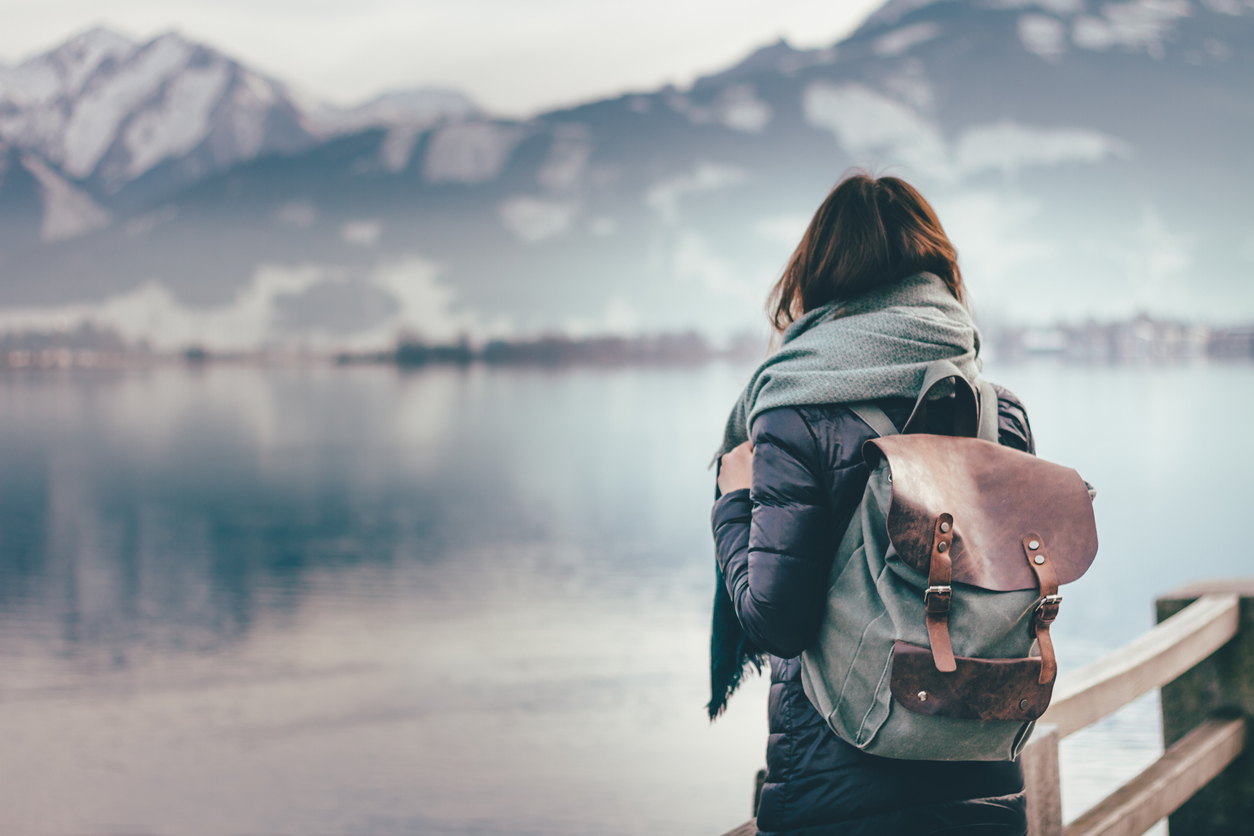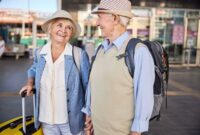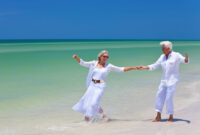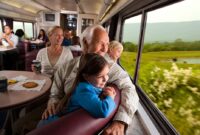Senior woman traveling alone presents unique opportunities and challenges. This guide explores the practical aspects of solo travel for older women, focusing on safety, planning, health, and cultural considerations. We’ll delve into creating a fulfilling and secure travel experience, from choosing suitable accommodations and transportation to managing finances and navigating cultural nuances. The aim is to empower senior women to confidently embark on their solo adventures.
Whether you’re dreaming of exploring bustling European cities, tranquil national parks, or embarking on a relaxing cruise, careful planning and preparation are key to a successful trip. This comprehensive guide addresses common concerns and provides actionable strategies to help you make the most of your solo journey, ensuring both safety and enjoyment.
Safety Concerns and Precautions
Traveling solo as a senior woman presents unique safety considerations. While the rewards of independent exploration are significant, it’s crucial to prioritize personal safety throughout the journey. Proactive planning and a cautious approach can significantly mitigate risks and ensure a more enjoyable and worry-free trip.
Common Safety Concerns for Senior Women Traveling Solo
Senior women traveling alone may face a higher risk of certain types of crime, such as theft, scams, and harassment. Physical limitations may also increase vulnerability in unfamiliar environments. Furthermore, medical emergencies can be particularly challenging to manage without a travel companion. These concerns, however, shouldn’t deter travel; rather, they highlight the importance of careful planning and preparedness.
Practical Safety Measures and Preventative Actions
Taking proactive steps significantly reduces potential risks. This includes thoroughly researching destinations, choosing reputable accommodations, and sharing itinerary details with family or friends. Staying in well-lit and populated areas, particularly at night, is crucial. Being aware of surroundings and avoiding displaying expensive jewelry or large amounts of cash are also vital preventative measures. Learning basic phrases in the local language can be helpful in seeking assistance.
Strategies for Avoiding Potentially Dangerous Situations
Avoiding potentially dangerous situations requires a blend of awareness and common sense. Trusting instincts is paramount; if a situation feels unsafe, it’s best to remove oneself from it. Avoiding walking alone at night in poorly lit areas is a simple but effective precaution. Being cautious about accepting unsolicited help or engaging with strangers is also important. Utilizing reputable transportation services and avoiding isolated areas are additional strategies for enhancing safety.
Essential Safety Items Checklist for a Solo Trip
A well-prepared checklist ensures essential safety items are readily available.
- Emergency contact information (printed and digital copies)
- Copies of important documents (passport, visa, travel insurance)
- Personal locator beacon (PLB) or satellite messenger
- First-aid kit with necessary medications
- Pepper spray or personal alarm
- Portable charger for electronic devices
- Money belt or hidden pouch for valuables
Comparison of Travel Insurance for Senior Women
Choosing the right travel insurance is crucial. Policies vary significantly in coverage and cost. Consider the level of medical coverage, emergency assistance services, and destination-specific risks when selecting a plan.
| Destination Coverage | Medical Coverage | Emergency Assistance | Cost |
|---|---|---|---|
| Worldwide | $1,000,000 | 24/7 helpline, medical evacuation | $150 |
| North America | $500,000 | Emergency medical transport | $75 |
| Europe | $750,000 | Repatriation of remains | $100 |
| Specific Country | Variable | Variable | Variable |
Health and Wellness
Planning for health and wellness is paramount for senior solo travelers, ensuring a safe and enjoyable experience. Prioritizing your well-being before, during, and after your trip is crucial for a successful adventure. This section will outline key considerations for maintaining your health while traveling alone.
Pre-Trip Medical Consultations
A pre-trip consultation with your physician is essential. This visit allows you to discuss potential health risks associated with your destination and the planned activities. Your doctor can review your current medications, recommend necessary vaccinations or preventative measures, and provide guidance on managing any pre-existing conditions during your trip. They can also advise on appropriate travel insurance that covers medical emergencies and evacuations. For example, if you have a heart condition, your doctor might recommend carrying extra medication and a detailed plan for managing any potential cardiac events while abroad. Discussions about altitude sickness if traveling to mountainous regions, or the need for malaria prophylaxis in certain areas, are also crucial aspects of this consultation.
Essential Medications and First-Aid Supplies
Carrying a comprehensive first-aid kit and sufficient medication is vital. This should include prescription medications with copies of prescriptions, over-the-counter pain relievers (such as ibuprofen or acetaminophen), anti-diarrheal medication, antiseptic wipes, bandages, and any personal medical supplies you may need. A detailed list of your medications, dosages, and potential side effects, along with your doctor’s contact information, should be kept separately from your medication in case of loss or theft. It’s also wise to carry a small supply of any allergy medications you require.
Potential Health Risks Associated with Long-Distance Travel for Seniors
Long-distance travel presents unique health challenges for seniors. Jet lag, dehydration, exposure to new germs and pathogens, and the physical strain of travel can exacerbate pre-existing conditions or lead to new health problems. For instance, deep vein thrombosis (DVT) is a risk for prolonged periods of immobility during flights. Changes in diet and water quality can also cause digestive issues. Furthermore, the stress of navigating unfamiliar environments and managing logistics alone can negatively impact mental and physical health. Consider consulting your physician about strategies for mitigating these risks.
Strategies for Maintaining Physical and Mental Well-being During Solo Travel
Maintaining physical and mental well-being while traveling alone requires proactive planning and self-care. Regular exercise, even light stretches or walks, can combat the effects of inactivity and improve circulation. Mindfulness techniques like meditation or deep breathing exercises can help manage stress and anxiety. Staying hydrated, eating nutritious meals, and getting sufficient sleep are also critical. Scheduling regular breaks throughout the day and avoiding over-exertion are essential. Connecting with family and friends through technology can provide emotional support and reduce feelings of loneliness. Remember to listen to your body and prioritize rest when needed.
Daily Schedule Incorporating Exercise and Relaxation
A sample daily schedule might include: Morning: Gentle stretching or yoga (15 minutes); Mid-morning: Sightseeing or walking tour (adjust duration based on energy levels); Afternoon: Relaxation break (meditation or quiet time, 15-20 minutes); Late afternoon: Light exercise, such as a swim or walk (30 minutes); Evening: Relaxing activity such as reading or journaling before bed. This is a flexible schedule and should be adjusted based on individual needs and preferences. Remember to incorporate regular hydration and nutritious meals throughout the day.
End of Discussion
Ultimately, the experience of a senior woman traveling alone is deeply personal and rewarding. By understanding the potential challenges and implementing the strategies outlined in this guide, older women can confidently and safely explore the world on their own terms. Remember that thorough planning, a proactive approach to safety, and a spirit of adventure are the cornerstones of a fulfilling solo trip. Embrace the journey and create unforgettable memories.




